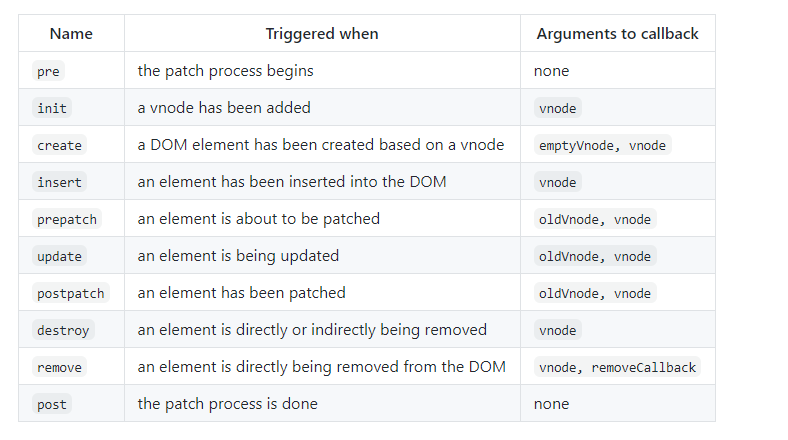createComponent
在前面介绍createElement方法的过程中,我们提到过有两处都调用了createComponent方法,在这一节我们来详细分析一下createComponent方法的实现逻辑。
createComponent是定义在src/core/vmode/create-component.js文件中的,其代码如下:
export function createComponent (
Ctor: Class<Component> | Function | Object | void,
data: ?VNodeData,
context: Component,
children: ?Array<VNode>,
tag?: string
): VNode | Array<VNode> | void {
// ...省略其它
const baseCtor = context.$options._base
// plain options object: turn it into a constructor
if (isObject(Ctor)) {
Ctor = baseCtor.extend(Ctor)
}
data = data || {}
// resolve constructor options in case global mixins are applied after
// component constructor creation
resolveConstructorOptions(Ctor)
// install component management hooks onto the placeholder node
installComponentHooks(data)
// return a placeholder vnode
const name = Ctor.options.name || tag
const vnode = new VNode(
`vue-component-${Ctor.cid}${name ? `-${name}` : ''}`,
data, undefined, undefined, undefined, context,
{ Ctor, propsData, listeners, tag, children },
asyncFactory
)
// ...省略其它
return vnode
}
因为createComponent方法要实现的功能点有很多,以上是我们的精简代码,其中被精简掉的代码有:组件检验相关、异步组件相关、获取prosData相关、抽象组件相关以及weex相关。
在分析createComponent方法的时候,我们主要关注两个方面的内容:构造子类构造函数和安装组件钩子函数。至于最后的创建组件VNode并返回VNode,则是最简单的,在这一步我们只需要知道创建组件VNode的时候,向VNode构造函数传递的第三个参数children为undefined,也就是说组件VNode没有children子节点,因为其值为undefined。
代码分析:
- 构造子类构造函数:在代码最开始,首先通过
$options._base拿到基础构造函数,这个基础构造函数也就是大Vue的构造函数,$options._base赋值过程是在initGlobalAPI函数执行的过程中赋值的。
export function initGlobalAPI (Vue) {
Vue.options._base = Vue
}
根据我们之前介绍的规则,我们在options上的属性,可以在后续通过$options拿到,这是因为在this._init方法的执行过程中,进行了mergeOptions配置合并。
vm.$options = mergeOptions(
resolveConstructorOptions(vm.constructor),
options || {},
vm
)
我们再来看一下createComponent的第一个参数,以App.vue组件为例:
import HelloWorld from '@/components/HelloWorld.vue'
export default {
name: 'App',
data () {
return {
msg: 'message',
age: 23,
list: [1, 2, 3]
}
},
components: {
HelloWorld
}
}
我们在App.vue组件中export导出的是一个对象,其中对象定义了name、data以及components三个属性,那么Ctor参数就应该是这个对象,但当我们真实调试的时候却发现Ctor属性比我们想象的还要多,这是因为vue-loader在处理.vue文件的时候默认帮我们做了一些处理,以下是App.vue真实调试时的Ctor参数:
const Ctor = {
beforeCreate: [function () {}],
beforeDestroy: [function () {}],
components: {
HelloWorld
},
data () {
return {
msg: 'message',
age: 23,
list: [1, 2, 3]
}
},
name: 'App',
render: function () {},
staticRenderFns: [],
__file: './App.vue',
_compiled: true
}
接下来,我们来看一下baseCtor.extend,全局的extend方法的定义位置我们已经在之前介绍过了,它是在initGlobalAPI方法中调用initExtend时被定义的,其中initExtend定义在src/core/global-api/extend.js文件中,代码如下:
export function initExtend (Vue: GlobalAPI) {
Vue.cid = 0
let cid = 1
Vue.extend = function (extendOptions: Object): Function {
extendOptions = extendOptions || {}
const Super = this
const SuperId = Super.cid
const cachedCtors = extendOptions._Ctor || (extendOptions._Ctor = {})
if (cachedCtors[SuperId]) {
return cachedCtors[SuperId]
}
const name = extendOptions.name || Super.options.name
if (process.env.NODE_ENV !== 'production' && name) {
validateComponentName(name)
}
const Sub = function VueComponent (options) {
this._init(options)
}
Sub.prototype = Object.create(Super.prototype)
Sub.prototype.constructor = Sub
Sub.cid = cid++
Sub.options = mergeOptions(
Super.options,
extendOptions
)
Sub['super'] = Super
// For props and computed properties, we define the proxy getters on
// the Vue instances at extension time, on the extended prototype. This
// avoids Object.defineProperty calls for each instance created.
if (Sub.options.props) {
initProps(Sub)
}
if (Sub.options.computed) {
initComputed(Sub)
}
// allow further extension/mixin/plugin usage
Sub.extend = Super.extend
Sub.mixin = Super.mixin
Sub.use = Super.use
// create asset registers, so extended classes
// can have their private assets too.
ASSET_TYPES.forEach(function (type) {
Sub[type] = Super[type]
})
// enable recursive self-lookup
if (name) {
Sub.options.components[name] = Sub
}
// keep a reference to the super options at extension time.
// later at instantiation we can check if Super's options have
// been updated.
Sub.superOptions = Super.options
Sub.extendOptions = extendOptions
Sub.sealedOptions = extend({}, Sub.options)
// cache constructor
cachedCtors[SuperId] = Sub
return Sub
}
}
我们看一下Vue.extend方法最核心的几段代码:
const Super = this
const Sub = function VueComponent (options) {
this._init(options)
}
Sub.prototype = Object.create(Super.prototype)
Sub.prototype.constructor = Sub
在extend方法中,使用了非常经典的寄生组合继承的方式,来让Sub子类去继承父类的属性和方法。在原型继承之前,首先调用了this._init方法,这个方法的逻辑我们在之前已经提到过了,这里就不再累述。原型继承后,Sub子类就拥有了Super父类全部的属性和方法,例如:
const Super = function () {
this.id = 1
this.name = 'Super'
}
Super.prototype.say = function () {
console.log('hello Super')
}
const Sub = function () {
Super.call(this)
}
Sub.prototype = Object.create(Super.prototype)
Sub.prototype.constructor = Sub
const sub = new Sub()
console.log(sub.id) // 1
console.log(sub.name) // Super
sub.say() // hellp Super
我们来看另外几段代码:
const cachedCtors = extendOptions._Ctor || (extendOptions._Ctor = {})
if (cachedCtors[SuperId]) {
return cachedCtors[SuperId]
}
cachedCtors[SuperId] = Sub
这几段代码是用来缓存的,作用是:如果我们先在A.vue文件中引入了header.vue组件,它会执行一遍extend,随后我们又在B.vue文件中引入了header.vue,由于已经有了header.vue组件的缓存,因此不再执行后续的代码,直接返回。
// A.vue
import MHeader from '@/components/header.vue'
export default {
name: 'AComponent',
components: {
MHeader
}
}
// B.vue
import MHeader from '@/components/header.vue'
export default {
name: 'BComponent',
components: {
MHeader
}
}
// header.vue只会extend一次。
最后在继承完毕后,还处理了props、computed以及各种全局API方法,这部分的逻辑跟之前我们提到过的是一样的,不再此累述。
- 安装组件钩子函数:我们在前面提到过,
Vue中的虚拟DOM借鉴了开源库snabbdom的实现,在这个库里面当VNode节点处于不同的场景下,提供了对应的钩子函数来方便我们处理相关的逻辑,这些钩子函数如下:

在Vue中也用到了这些钩子函数,它的定义如下:
const componentVNodeHooks = {
init: function () {}, // 初始化时触发
prepatch: function () {}, // patch之前触发
insert: function () {}, // 插入到DOM时触发
destroy: function () {} // 节点移除之前触发
}
我们来看一下,installComponentHooks方法的定义:
const hooksToMerge = Object.keys(componentVNodeHooks)
function installComponentHooks (data: VNodeData) {
const hooks = data.hook || (data.hook = {})
for (let i = 0; i < hooksToMerge.length; i++) {
const key = hooksToMerge[i]
const existing = hooks[key]
const toMerge = componentVNodeHooks[key]
if (existing !== toMerge && !(existing && existing._merged)) {
hooks[key] = existing ? mergeHook(toMerge, existing) : toMerge
}
}
}
在installComponentHooks方法执行的时候,遍历了我们定义的hooks对象的属性,然后在遍历的过程中把这些hook赋值到我们传递的参数上面,其中有一个地方值得我们注意:如果已经有了相同的hook,则会执行mergeHook来合并,mergeHook方法的定义如下:
function mergeHook (f1: any, f2: any): Function {
const merged = (a, b) => {
// flow complains about extra args which is why we use any
f1(a, b)
f2(a, b)
}
merged._merged = true
return merged
}
我们以下面代码为例,来举例说明:
// 合并前
const hooks = {
init: function () {
console.log('init hook 1')
}
}
const vnode = {
data: {
hook: {
init: function () {
console.log('init hook 2')
}
}
}
}
// 合并
mergeHook()
// 合并后
const vnode = {
data: {
hook: {
init: () => {
init1(),
init2()
}
}
}
}
在createComponent这一小节,我们介绍了组件会进行mergeOptions配置合并,为了更好的理解path的过程,我们会在接下来的小节优先介绍mergeOptions配置合并策略。